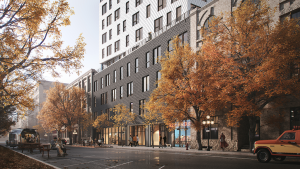Point Douglas is one of Winnipeg’s oldest neighbourhoods and one of its most interesting, if one takes the time to look around a bit.
It is also one of the city’s poorest, a world away from the condos on Waterfront Drive and the heritage buildings in the Exchange District, just a few blocks south.
“It’s well located – close to the centre of town – but it’s full of crumbling buildings and old housing stock, some from before 1900,” said Christopher Adams, adjunct professor of political studies at the University of Manitoba.
However, two recently announced initiatives just might put a spring in Point Douglas’s step again if they come to fruition.
A group of Winnipeggers want to create a new national urban park in Point Douglas near where the Red, Assiniboine and Seine Rivers meet.
Called Little Forks, the park would be anchored at the tip of Point Douglas and extend north, south and west from there, taking in a large area where the Seine, which meanders through southeast Winnipeg, empties into the Red.
The project also calls for the creation of nature preserves, recreational trails, ceremonial and gathering places and places of historical significance to First Nations and Métis.
A portion of the proposed park would be located in south Point Douglas, a once-busy industrial area now full of empty land and derelict buildings.
Much of the rest of the proposed park would be in north Point Douglas, a mostly residential neighbourhood located north of the CPR mainline.
Making the dream a reality will require a joint ownership and management agreement between governments and Indigenous and community organizations.
It would also mean acquiring private property, rehabilitating former industrial lands and restoring degraded sites.
Proponents hope to convince the federal government to approve and help fund the park, since it promised $130 million to create a network of national urban parks in 2021.
Jean Trottier, associate professor of landscape architecture at the University of Manitoba and Little Forks project lead, said Winnipeg’s core area has a shortage of parks and green space.
“Our proposal is a bit like Vancouver’s downtown, with a continuous public waterfront corridor and a public park at the tip of the peninsula: Stanley Park in Vancouver and the heart of the proposed park at the tip of Point Douglas,” said Trottier.
Sel Burrows, long-time community activist and a member of the planning group, said Winnipeg’s inner city has the highest crime rate in Canada.
“A national park with access to our wonderful rivers would be a significant crime reduction step, as well as recognition that poorer areas require positive social investment,” said Burrows. “It’s important symbolically. Nothing gets done in the inner city.”
Meanwhile, a few blocks down Main Street, the City of Winnipeg wants Point Douglas residents to help come up with a plan that will help guide the development of the neighbourhood.
The Point Douglas Neighbourhood Plan is intended to create a collective long-term vision.
The city’s project team will attend events in the community and meet with residents, landowners and other stakeholders to find out what the locals want for Point Douglas.
The plan will determine what types of housing gets built and what it will look like as well as inform decisions about future transit, industrial and transportation development.
Senior Winnipeg city planner James Platt said future development of Point Douglas could follow a similar path as Waterfront Drive, which also used to be heavily industrial, but now contains a mix of residential and commercial buildings.
Engagement with the locals begins in August and will last into the winter.
“It’s a unique neighbourhood and we want to take the time to get to know the residents and work with neighbourhood groups,” said Platt. “We want to do it right.”
Aaron Moore, University of Winnipeg professor of political science, said Point Douglas won’t rise again on its own.
“It’s cut off from the rest of the city,” said Moore. “What happens to Point Douglas, especially south Point Douglas, depends to a large extent on how well downtown recovers and develops.”
One advantage Point Douglas has is that it’s cheap.
“That could help attracting young people to Winnipeg and keeping them here,” he said.
Winnipeg historian Christian Cassidy said pulling off the projects won’t be easy.
“They are big sites, and many private landowners will have to be willing to sell in order to make the neighbourhood plan a reality.
“These industrial sites have been in decline for many years and I hope it doesn’t take 40 or 50 years to start seeing an improved neighbourhood materialize.”






Recent Comments
comments for this post are closed